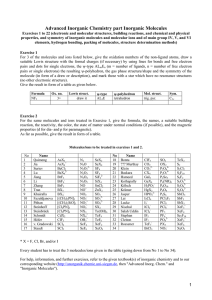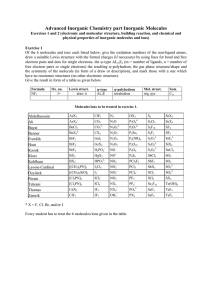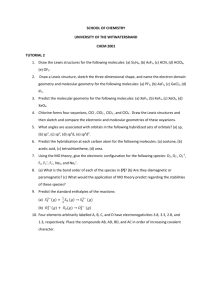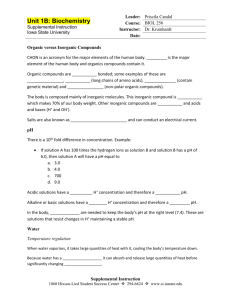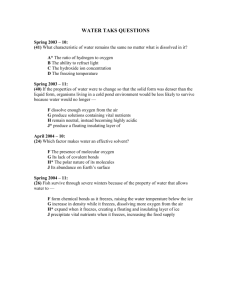Exercises
advertisement
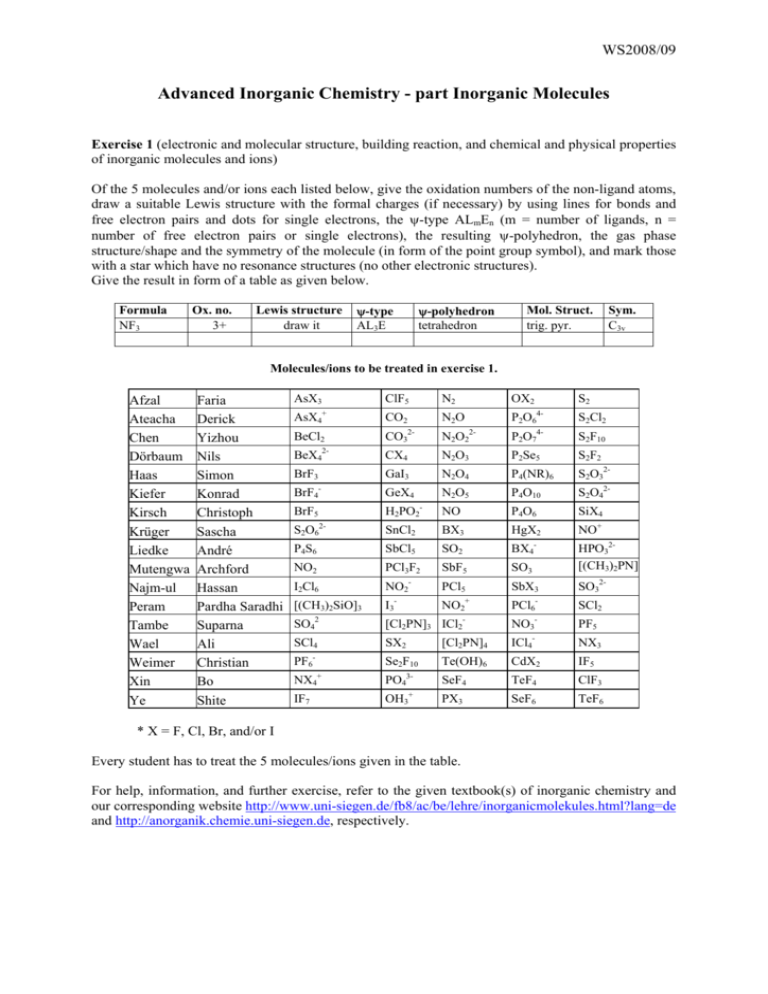
WS2008/09 Advanced Inorganic Chemistry - part Inorganic Molecules Exercise 1 (electronic and molecular structure, building reaction, and chemical and physical properties of inorganic molecules and ions) Of the 5 molecules and/or ions each listed below, give the oxidation numbers of the non-ligand atoms, draw a suitable Lewis structure with the formal charges (if necessary) by using lines for bonds and free electron pairs and dots for single electrons, the ψ-type ALmEn (m = number of ligands, n = number of free electron pairs or single electrons), the resulting ψ-polyhedron, the gas phase structure/shape and the symmetry of the molecule (in form of the point group symbol), and mark those with a star which have no resonance structures (no other electronic structures). Give the result in form of a table as given below. Formula NF3 Ox. no. 3+ Lewis structure draw it ψ-type AL3E ψ-polyhedron tetrahedron Mol. Struct. trig. pyr. Sym. C3v Molecules/ions to be treated in exercise 1. Afzal Ateacha Chen Dörbaum Haas Kiefer Kirsch Krüger Liedke Mutengwa Najm-ul Peram Tambe Wael Weimer Xin Ye Faria Derick Yizhou Nils Simon Konrad Christoph Sascha André Archford Hassan Pardha Saradhi Suparna Ali Christian Bo Shite AsX3 ClF5 + AsX4 BeCl2 CO2 N2 OX2 N2O 2- S2 4- S2Cl2 4- P2O6 2- CO3 N2O2 P2O7 S2F10 BeX4 CX4 N2O3 P2Se5 S2F2 BrF3 GaI3 N2O4 P4(NR)6 S2O32- BrF4- GeX4 N2O5 P4O10 S2O42- BrF5 H2PO2- NO P4O6 SiX4 SnCl2 BX3 HgX2 NO+ 2- 2- S2O6 P4S6 SbCl5 SO2 BX4 NO2 PCl3F2 SbF5 SO3 HPO32[(CH3)2PN] I2Cl6 NO2 PCl5 SbX3 SO32- [(CH3)2SiO]3 I3- NO2+ PCl6- SCl2 2 - - - - SO4 [Cl2PN]3 ICl2 NO3 PF5 SCl4 SX2 [Cl2PN]4 ICl4- NX3 PF6- Se2F10 + NX4 IF7 Te(OH)6 CdX2 IF5 3- SeF4 TeF4 ClF3 + PX3 SeF6 TeF6 PO4 OH3 * X = F, Cl, Br, and/or I Every student has to treat the 5 molecules/ions given in the table. For help, information, and further exercise, refer to the given textbook(s) of inorganic chemistry and our corresponding website http://www.uni-siegen.de/fb8/ac/be/lehre/inorganicmolekules.html?lang=de and http://anorganik.chemie.uni-siegen.de, respectively. WS2008/09 Advanced Inorganic Chemistry - part Inorganic Molecules Exercise 2 (electronic and molecular structure, building reaction, and chemical and physical properties of inorganic molecules and ions) Of the 5 molecules and/or ions each listed below, give the formula, the names, a suitable building reaction, the reactivity, the color, the state of matter under normal conditions (if possible), and the magnetic properties (d for dia- and p for paramagnetic). As far as possible, give the results in form of a table. Molecules/ions to be treated in exercise 2. Afzal Ateacha Chen Dörbaum Haas Kiefer Kirsch Krüger Liedke Mutengwa Najm-ul Peram Tambe Wael Weimer Xin Ye Faria Derick Yizhou Nils Simon Konrad Christoph Sascha André Archford Hassan Pardha Saradhi Suparna Ali Christian Bo Shite AsX3 ClF5 + AsX4 BeCl2 2- CO2 N2 OX2 N2O 2- CO3 S2 4- S2Cl2 4- S2F10 P2O6 2- N2O2 P2O7 BeX4 CX4 N2O3 P2Se5 S2F2 BrF3 GaI3 N2O4 P4(NR)6 S2O32- BrF4- GeX4 N2O5 P4O10 S2O42- BrF5 H2PO2- NO P4O6 SiX4 S2O6 SnCl2 BX3 HgX2 NO+ P4S6 SbCl5 SO2 BX4- NO2 PCl3F2 SbF5 SO3 HPO32[(CH3)2PN] 2- I2Cl6 NO2 PCl5 SbX3 SO32- [(CH3)2SiO]3 I3- NO2+ PCl6- SCl2 2 SO4 SCl4 - PF6 + NX4 IF7 - - [Cl2PN]3 ICl2 - PF5 - NO3 SX2 [Cl2PN]4 ICl4 NX3 Se2F10 Te(OH)6 CdX2 IF5 3- SeF4 TeF4 ClF3 + PX3 SeF6 TeF6 PO4 OH3 * X = F, Cl, Br, and/or I Exercise 3 Name the number of covalent bonds, the elements P, S, and Cl can build. Exercise 4 Explain why the compounds or ions SiF62-, PF5, SF6 do exist and CF62-, NF5, OF6 do not. Exercise 5 Sketch the Lewis structures of N2, NH3, and S2 and explain why these molecules do not have different resonance structures. Exercise 6 Explain why P4O6, and P4O10 are built instead of P2O3 and P2O5, respectively. Exercise 7 (Cl2PN)3 was found to have symmetry D3h. Please explain why it is not aromatic. WS2008/09 Advanced Inorganic Chemistry - part Inorganic Molecules Exercise 8 Sketch the molecular and Lewis structures and give the symmetry groups of “P2O3”, P2O5”, and P4S6. Write a reasonable Lewis structure of (Cl2PN)3 and explain whether and why it is aromatic or not. Exercise 9 Sketch the Lewis structures and the expected and found molecular structures and give the names and the symmetry groups (Schönflies or Hermann/Mauguin) of ”P2O5” P2O64-, (Cl2PN)3, P4S6, and P2Se5. Exercise 10 Sketch and explain the MO's of N2 and HF. Exercise 11 Name and describe structurally (coordination, molecular structure, differences/relations of bond lengths and angles, structure type, crystal system) the main group IV, V, and VI elements. Exercise 12 Name and describe structurally (coordination, molecular structure, differences/relations of bond lengths and angles, structure type, crystal system) the thermodynamically stable forms of the main group IV, V, and VI elements. Exercise 13 Sketch the Lewis structures and the expected and found molecular structures and give the names and the symmetry groups (Schönflies or Hermann/Mauguin) of the oxides and oxoions of C, N, P, and S. Exercise 14 Give the ranges of energies and wavelengths of X-ray, UV/Vis, and IR radiation. Name and describe the structure determination methods based on these radiations and explain the respective physical processes. Exercise 15 Sketch the principle parts of an IR spectrometer and a X-ray diffraction device and describe the main differences between IR spectroscopy and X-ray diffraction concerning the principle processes, selection rules, changes of energy etc., and their meaning for the structure determination of inorganic molecules. Exercise 16 Sketch the principle parts of an IR and a Raman spectrometer and describe the main differences between IR and Raman spectroscopy concerning the principle processes, selection rules, and their meaning for the structure determination of inorganic molecules. Exercise 17 Name two common structure determination methods based on different types of electromagnetic radiation with their ranges of energies and wavelengths each and the respective physical processes. Exercise 18 Name and specify the factors and forces affecting the crystal structures of molecular solids. For help, information, and further exercise, refer to the given textbook(s) of inorganic chemistry and our corresponding website http://www.uni-siegen.de/fb8/ac/be/lehre/inorganicmolekules.html?lang=de and http://anorganik.chemie.uni-siegen.de, respectively.
